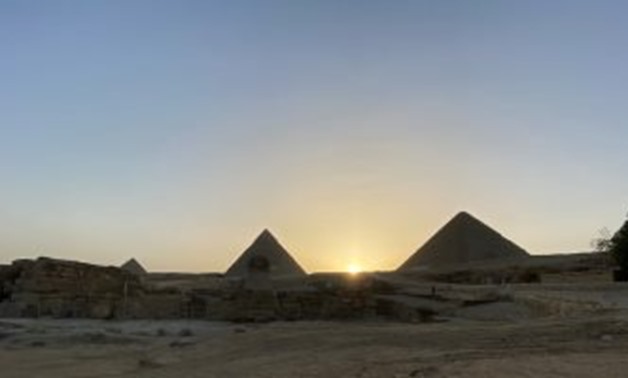
Solstice phenomenon occurs when the sun sets between the Pyramids of Cheops and Khafre - ET
CAIRO – 23 June 2020: On June 22, Egyptian archaeologist Zahi Hawass and Mark Liner, who specializes in the antiquities of Giza, witnessed the summer solstice phenomenon, as the sun set between the Pyramid of Cheops and Pyramid of Khafre.
Hawas explained that this phenomenon occurs annually between June 21 and 22 and it is, according to Hawass and Liner, the most important solar phenomenon that occurs in Egypt.
Hawass further stated that the sun illuminates the shoulder of the Sphinx annually on March 21/22, as well as September 21/22.
Moreover, Hawass indicated that these solar phenomena can be used to encourage tourism in Egypt, as it may be more intriguing to tourists than the phenomenon of the sun illuminating Abu Simbel Temple.
Zahi Hawas was born in a small village near Damietta, Egypt, in 1947. He dreamed of becoming a lawyer. However, he obtained a bachelor's degree in Arts in Greek and Roman Antiquities from Alexandria University in 1967.
At the age of 33, Hawass received a Fulbright Fellowship to attend the University of Pennsylvania in Philadelphia to study Egyptology. He then obtained a master’s degree in Arts in Egyptology and Syrian-Palestinian Antiquities in 1983. Hawass obtained his PhD in Egyptology in 1987.
The renowned archeologist was appointed to the position of chief inspector of the Giza Plateau, but he quit in 1993. Then, he returned to the position of chief inspector in early 1994, and in 1998, Hawass was appointed director of the Giza Plateau.
During his work at the pyramids, Hawass discovered the tombs of the pyramid builders in Giza and the Valley of the Golden Mummies in Bahariya Oasis.
Hawass was appointed as the first minister of state for antiquities after January 25, 2011.
Comments
Leave a Comment